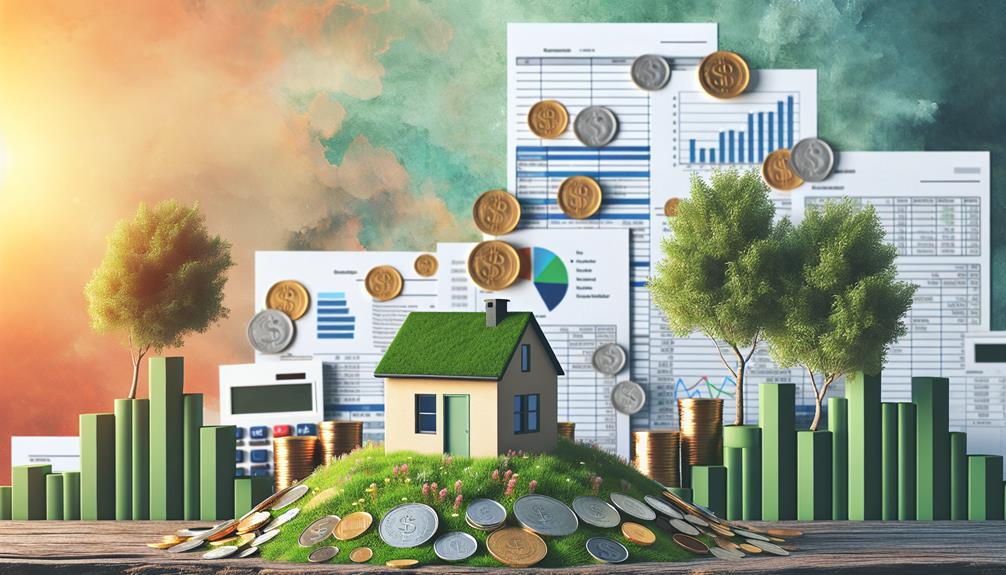Have you ever dreamt of simplifying your life with a tiny home, only to be stumped by the financial logistics? You're not alone. Navigating the maze of tiny home financing can seem daunting, but with the right guidance, you'll find there are more options at your disposal than you might think.
Whether you're considering dipping into your savings, securing a personal loan, or exploring more creative avenues, it's crucial to weigh the advantages and disadvantages of each method. As you assess your budget and ponder loan types, keep in mind that traditional mortgages might not be applicable, leading you to alternative solutions that could better suit your diminutive dwelling.
In the subsequent sections, we'll unravel these complexities and equip you with the knowledge to make an informed decision that aligns with your financial situation and tiny home aspirations.
Key Takeaways
- Evaluating your monthly income and expenses is crucial when assessing your budget for a tiny home, including considering land, utilities, and maintenance costs.
- Understanding different loan types, such as personal loans, RV loans, and home equity loans, will help you choose the financing option that aligns with your financial situation and needs.
- Exploring alternative financing options, such as RV loans that meet RVIA requirements, unsecured personal loans, builder financing, credit cards, or leveraging home equity, can provide flexibility in financing a tiny home.
- Preparing for the application process involves verifying local zoning rules, checking your credit score in advance, gathering essential financial documents, and being aware of down payment and land location requirements.
Assessing Your Budget
Before diving into the dream of tiny home living, it's crucial to take a hard look at your finances to gauge what you can realistically afford.
Calculate your monthly income against expenses to discern your tiny home financing capacity. Remember to include land, utilities, and maintenance costs in your budget.
Assess various financing options, from personal loans and RV loans to home equity loans, weighing their loan terms against your financial health. Your credit score is pivotal; it influences interest rates, monthly payments, and repayment terms. A strong credit score could secure you more favorable conditions, while lower credit scores might saddle you with high interest rates.
Complete a thorough loan application to ensure you don't commit to a financial strain. Stay informed and choose wisely to make your tiny home a sustainable reality.
Understanding Loan Types
When considering how to finance your tiny home, it's essential to understand the different loan types available and how they align with your financial situation.
Personal loans, offered by various lenders, are unsecured and tailored to your creditworthiness, often carrying higher interest rates due to the lack of collateral.
For mobile residences, RV loans cater specifically to tiny homes on wheels, boasting interest rates between 4.5% and 7.5% alongside reasonable repayment terms that make them an attractive option.
Alternatively, tapping into a home equity loan can provide lower interest rates and extended repayment terms, utilizing your existing home's equity as security.
Exploring Alternative Financing

Explore alternative financing options to secure the funds for your tiny home, considering the unique advantages that each alternative offers to fit your lifestyle and budget constraints.
If your tiny home is on wheels and meets RVIA requirements, you might qualify for an RV loan, a type of secured financing tailored for recreational vehicles.
Unsecured personal loans from online lenders can provide up to $100,000, offering a quick and flexible solution, although with higher interest rates.
Consider these innovative options:
- Builder financing: Directly integrates the cost into your home-building process.
- Credit cards: Useful for smaller purchases or as a short-term solution.
- Home equity: Leverages existing property value for competitive rates.
Each method presents a unique pathway to financing your tiny dream, ensuring you can manage the investment wisely.
Preparing for the Application
To streamline your tiny home financing application, you'll need to verify local zoning rules and secure a land location before gathering essential financial documents. Ensure your credit history reflects your ability to secure a loan by checking your credit score in advance—having excellent credit can be a game changer, while bad credit may require additional steps to qualify.
Here's a quick checklist to help you prepare:
| Requirement | Purpose | Examples |
|---|---|---|
| Proof of Income | To demonstrate financial stability | Pay stubs, Tax Returns |
| Credit History | To assess creditworthiness | Credit Reports |
| Down Payment | To meet financing requirements | Savings, Gifted Funds |
| Land Location | To comply with zoning and RVIA | Deed, Lease Agreement |
Familiarize yourself with the loan amount and down payment requirements. Collect recent pay stubs, utility bills, and any other documents to show you meet the requirements to qualify.
Managing Tiny Home Costs

Understanding the full spectrum of costs associated with tiny home living is essential for making an informed financial decision that aligns with your budget and lifestyle. Whether you're purchasing a tiny home outright or seeking a loan for a tiny house, consider these key factors:
- Zoning regulations may impact where you can place your tiny home and thus the cost of your tiny dwelling.
- The choice between a prefabricated tiny home or a kit-built one affects the initial investment.
- Tiny homes offer overall cost savings but require a clear financial strategy.
Exploring financing options beyond a traditional mortgage is crucial. Tiny house loans, personal loans, and even RV loans offer alternative pathways to finance a tiny home. Remember, shorter repayment terms might increase monthly expenses but lead to faster ownership. Assess all angles to ensure buying a tiny home is a smart, innovative move for you.
Frequently Asked Questions
Is It Hard to Finance a Tiny Home?
Financing a tiny home can be tough due to zoning challenges, hefty down payments, and uncertain resale potential. However, it's a smart investment in alternative living, optimizing space, and reducing construction costs.
What Credit Score Is Needed for a Tiny House?
Navigating the seas of credit tiers, you'll need a score that reflects financial stability. Aim for a minimum of 580, factoring in debt ratio and down payment, to smooth the pre-approval process.
How Much Would a Monthly Payment Be on a Tiny Home?
Your monthly payment on a tiny home depends on down payment, loan terms, and interest rates. Factor in utility expenses, insurance costs, and potential resale value for smart monthly budgeting and investment foresight.
What Kind of Loan Can You Get on a Tiny Home?
You can secure an RV loan, chattel mortgage, or personal loan to fund your tiny home. Each has unique loan terms, down payments, and interest rates, with potential property liens on unsecured loans.
Conclusion
Navigating the financial seas of tiny home ownership can seem daunting, but with the right compass, you'll chart a course to your dream dwelling. Whether you're filling your treasure chest to pay in cash, harnessing the equity winds, or sailing the personal loan waters, ensure your credit map is clear and your budget shipshape.
By doing so, you'll drop anchor on a tiny home that doesn't capsize your fiscal voyage. Set sail wisely, and your tiny haven awaits.

